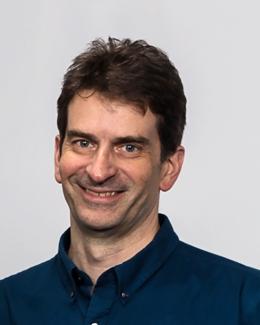Tom Karnowski (left) and Jordan Johnson (right). Credit: Carlos Jones/ORNL, U.S. Dept. of Energy
Tom Karnowski and Jordan Johnson of the Department of Energy’s Oak Ridge National Laboratory have been named chair and vice chair, respectively, of the East Tennessee section of the Institute of Electrical and Electronics Engineers, or IEEE. After expressing interest in volunteering with the local section, Karnowski, the group leader of the Cyber Sensing and Analytics group, and Johnson, a cyber security technical professional in the Embedded Systems Security group, were appointed to leadership roles as the organization returns to pre-COVID operation.
Starting out as volunteer members within the East Tennessee section, Karnowski and Johnson were brought into their new positions in an atypical manner, being asked to volunteer for appointment into leadership. In the winding down of the pandemic, the local IEEE section was searching for people to revitalize the membership.
“It has been a bit unusual,” Karnowski said. “The East Tennessee section was very active and had a healthy executive committee in place until COVID, which really took a lot out of the section.”
Karnowski, a long-time member of IEEE, recognized the importance of ORNL’s involvement within the organization at large. “As the largest Department of Energy Office of Science laboratory, we are responsible (for being) a leader in highlighting and enhancing technology in our area as well as in the nation,” he said. “Similarly, IEEE touches more of the research and development work going on at ORNL than any other professional society.”
And although ORNL represents an important demographic within IEEE, Karnowski and Johnson recognized the importance of engaging with the non-ORNL membership of the East Tennessee IEEE section. Karnowski said that they will “take care to not make the local section and its chapters overly ‘ORNL-centric,’ as there are a lot of members involved in a diverse array of different fields and interest.”
Karnowski believes his diverse experiences at ORNL will help him communicate the benefits of professional organizations such as IEEE. “I have worked as a technical professional in my early years at ORNL, as a SOTA, or Student Older Than Average while securing my PhD, and now as a group leader.” He believes an IEEE membership have benefitted him throughout his career – from guidance in journal and conference publications to access to insurance programs.
As for Johnson, his attendance at the IEEE Region-3 Southeast Conference where he was able to participate in the volunteer training and his positive working relationship with Karnowski have provided him with the resources needed for IEEE leadership.
“One of the vice chair’s primary roles is to support the section chair,” Johnson said. “I have known Tom for a few years and have worked with him on a couple of projects. He is a pleasure to work with, and I am looking forward to supporting him in this new role as well.”
In their new roles, Karnowski and Johnson aim to grow membership and highlight the work of IEEE members in the area, especially young engineers.
“I spend a lot of time on ORNL’s campus working with other young professionals on projects and in my group,” Johnson said. “I hope to get them plugged into our local section to help foster the young professional involvement.”
And although they are cautious about overextending themselves, Karnowski and Johnson are optimistic about the future of the East Tennessee section and are ready to tackle these new responsibilities.
“I am always a bit hesitant about taking on new roles,” said Karnowski, “but look forward to helping revitalize our local section.”
UT-Battelle manages ORNL for the Department of Energy’s Office of Science, the single largest supporter of basic research in the physical sciences in the United States. The Office of Science is working to address some of the most pressing challenges of our time. For more information, please visit energy.gov/science. — Lena Shoemaker




